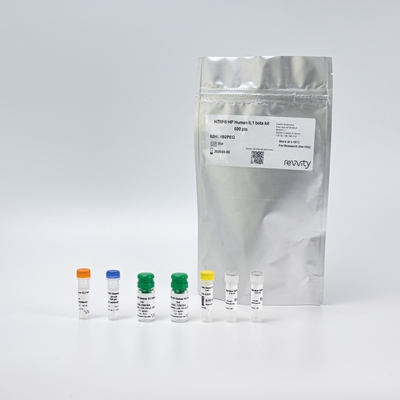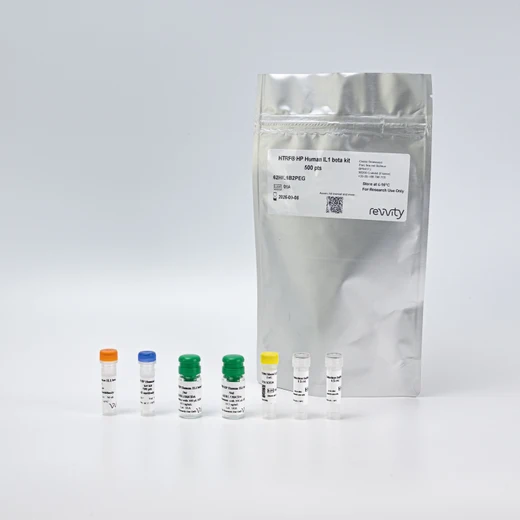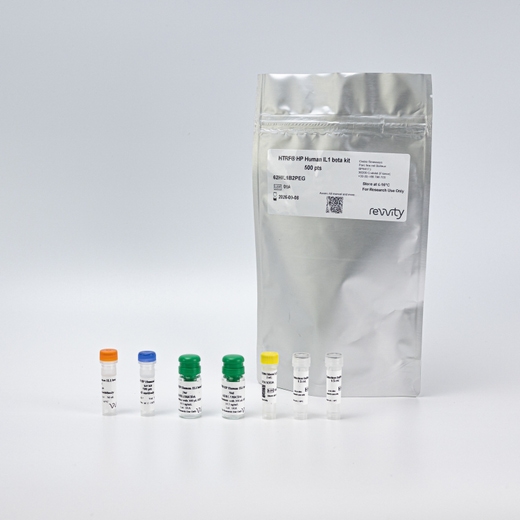

HTRF Human IL-1β High Performance Detection Kit, 500 Assay Points


HTRF Human IL-1β High Performance Detection Kit, 500 Assay Points






The HTRF High Performance Human IL-1β kit is designed for the quantification of human IL-1β release in cell supernatant. It replaces the existing HTRF human IL-1β kit.
| Feature | Specification |
|---|---|
| Application | Protein Quantification |
| Sample Volume | 16 µL |
The HTRF High Performance Human IL-1β kit is designed for the quantification of human IL-1β release in cell supernatant. It replaces the existing HTRF human IL-1β kit.



HTRF Human IL-1β High Performance Detection Kit, 500 Assay Points



HTRF Human IL-1β High Performance Detection Kit, 500 Assay Points



Product information
Overview
IL-1β, also known as leukocytic pyrogen or mononuclear cell factor, is a pro-inflammatory cytokine of the IL1 family. IL1 beta is considered to be a major endogenous pyrogen and induces prostaglandin synthesis, T cell activation, B cell activation, and subsequent antibody production. It is also a known promoter of T cell differentiation into Th17.
Assessment of serum samples often requires enhanced sensitivity. In some cases, AlphaLISA assays may have sufficient sensitivity to enable the detection of low levels of analytes in serum or plasma. Check out the Human IL-1β AlphaLISA kit's analytical performances for more information, or learn more about AlphaLISA. When assaying, always follow the recommended protocol and avoid highly haemolyzed samples.
Specifications
| Application |
Protein Quantification
|
|---|---|
| Brand |
HTRF
|
| Detection Modality |
HTRF
|
| Product Group |
Kit
|
| Sample Volume |
16 µL
|
| Shipping Conditions |
Shipped in Dry Ice
|
| Target Class |
Cytokines
|
| Target Species |
Human
|
| Technology |
TR-FRET
|
| Unit Size |
500 Assay Points
|
Video gallery

HTRF Human IL-1β High Performance Detection Kit, 500 Assay Points

HTRF Human IL-1β High Performance Detection Kit, 500 Assay Points

How it works
Assay principle
Cell supernatant, sample, or standard is dispensed directly into the assay plate for the detection by HTRF® reagents (384-well low-volume white plate or Revvity low-volume 96-well plate in 20 µl). The antibodies labeled with the HTRF donor and acceptor are pre-mixed and added in a single dispensing step to further streamline the assay procedure. The assay can be run up to a 1536-well format by simply resizing each addition volume proportionally.

Assay data analysis
The 4 Parameter Logistic (4PL) curve is commonly recommended for fitting an ELISA standard curve. This regression enables the accurate measurement of an unknown sample across a wider range of concentrations than linear analysis, making it ideally suited to the analysis of biological systems like cytokine releases.
To fully understand how to deal with HTRF data processing and also 4PL 1/y² fitting,
Revvity also worked with Myassays.com to help you in your data analyses. You’ll be able to access a free online software to run your IL1 beta analysis.
Assay details
Human IL-1β standard curve
The IL-1β standard curve is generated in the assay Diluent 5 provided in the kit.

Human IL-1β Assay Specifications
| Sample size | 16 µL |
|---|---|
| Final assay volume | 20 µL |
| Kit components | Lyophilized standard, frozen detection antibodies, buffers & protocol |
| LOD & LOQ (in Diluent) | 8.3 pg/mL & 18.8 pg/mL |
| LOD & LOQ (in DMEM+10%FCS) | 11.3 & 26.7 pg/mL |
| LOD & LOQ (in RPMI+10%FCS) | 15.3 & 28.5 pg/mL |
| Range | 75.8 – 6 500 pg/mL |
| Time to result | 4h at RT |
| Correspondance to I.S. | NIBSC (86/680) value (IU/mL) = 0,07 x HTRF hIL1ß value (pg/mL) |
| Species | Human only |
Analytical performance
Intra and inter assay
Intra-assay (n=24)
| Sample | Mean [IL-1ß] (pg/mL) | CV |
|---|---|---|
| 1 | 73.7 | 7% |
| 2 | 714.4 | 2% |
| 3 | 3406.8 | 2% |
| Mean CV | 4% |
Each of the 3 samples was measured 24 times, and the % CV was calculated for each sample.
Inter-assay (n=4)
| Sample | Mean [IL-1ß] (pg/mL) | CV |
|---|---|---|
| 1 | 76 | 9% |
| 2 | 702 | 8% |
| 3 | 3095 | 4% |
| Mean CV | 7% |
Each of the samples was measured in 4 different experiments, and the % CV was calculated for each sample.
Dilutional linearity
The excellent % of recovery obtained from these experiments show the good dilution linearity of the assay. Samples are PBMC supernatants serially diluted with the kit DIL5 diluent.
| Dilution Factor | [IL-1β] Expected (pg/mL) | [IL-1β] Measured (pg/mL) | Dilution Recovery |
|---|---|---|---|
| Neat | - | 951 | |
| 1.5 | 655 | 610 | 93% |
| 2.25 | 436 | 442 | 101% |
| 3.37 | 291 | 287 | 99% |
| 5.07 | 194 | 202 | 104% |
| Mean CV | 99% |
Antigen Spike and Recovery
Recombinant cytokine was added to PBMC supernatant samples, and the measured response was compared to the calculated expected values. The 100% of recovery indicates similar measurements of cytokine from a sample and the kit standard.
| Sample | [IL-1β] Spiked Sample (pg/mL) | [IL-1β] Standard (pg/mL) | Expected (pg/mL) | Measured (pg/mL) | Recovery |
|---|---|---|---|---|---|
| 1 | 982 | 3095 | 2039 | 1972 | 97% |
| 334 | 658 | 637 | 97% | ||
| 2 | 574 | 3095 | 1835 | 1720 | 94% |
| 334 | 454 | 384 | 84% | ||
| Mean CV | 93% | ||||
Cross reactivities
Cross reactivities were assessed using recombinant proteins from the IL-1 cytokine family. Proteins were tested up to 6 500 pg/mL, and standard curves were generated for each. Signals were interpolated on the assay standard curve to interpolate concentrations. The assay is human specific, as mouse IL-1β cytokines were not detected.
| Tested Protein | Cross Reactivity |
|---|---|
| Human IL-1β | 100% |
| Human IL-1α | 0% |
| Mouse IL-1β | 0% |
Assay validation
Modulation of secretion of human IL-1β in THP1 cell line
THP1 cells plated at 25, 50, and 100 kcells/well were stimulated for 18h with PMA and LPS, respectively used at 50 ng/mL and 1 µg/mL. 16 µL of supernatants were then transferred into a white detection plate (384 low volume) to be analyzed with the Human IL-1ß Assay.

IL-1ß secretion in PBMC stimulated with LPS
PBMC plated at 50, 100, and 200 kcells/well were stimulated for 18 h with increasing concentrations of LPS ranging from 0.02 to 2 µg/mL. Then 16 µL of supernatants were transferred into a white detection plate (384 low volume) to be analyzed using the Human IL-1ß assay kit.

Effect of dexamethasone on PBMC induced IL-1ß release
PBMC plated at 50 and 100 kcells/well were stimulated for 18h with 0.2 µg/mL of LPS and a co-treatment of increasing concentrations of dexamethasone, ranging from 0.05 to 50 µg/mL. Then 16 µL of supernatants were transferred into a white detection plate (384 low volume) to be analyzed using the Human IL-1ß Assay Kit.

Resources
Are you looking for resources, click on the resource type to explore further.
The definitive guide to setting up a successful cytokine assay
Many therapeutic areas require an understanding of cytokine release...
Discover the versatility and precision of Homogeneous Time-Resolved Fluorescence (HTRF) technology. Our HTRF portfolio offers a...
This guide provides you an overview of HTRF applications in several therapeutic areas.


How can we help you?
We are here to answer your questions.






























